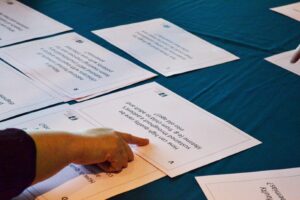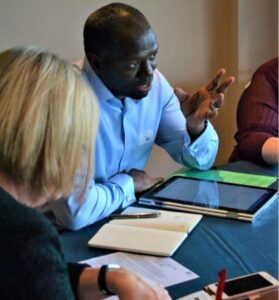This project used a tried and tested method to bring together patients, carers and healthcare professionals to shape future research into rare forms of anaemia.
By Dr Noémi Roy, Consultant Haematologist, Medical Research Council (MRC) Molecular Haematology Unit at the University of Oxford.
Historically, if you look at what research is done and what research is funded, it’s always been decided by doctors, scientists and the pharmaceutical industry. That’s because these are the people in a position to make those decisions. We have evidence that patient-driven research makes for more appropriate and also better-quality research.
I’m a clinical haematologist and I look after patients who have inherited anaemia. Patients with anaemia lack red blood cells, which means that these cells cannot carry oxygen from the lungs to other cells in the body. We’re trying to understand how the only available treatment works and more importantly, if we can find a better one.
Involving public voices
I lead a steering group for rare inherited anaemias, launched in 2016. The group includes researchers from the MRC Molecular Haematology Unit at the University of Oxford as well as clinicians, patients and patient support group representatives.
Our steering group completed a priority-setting project using the format of the James Lind Alliance Priority Setting Partnerships (PSPs). The aim was to determine which areas the group believed were most important for future research and to stimulate research on rare inherited anaemias.
Our reason for using the James Lind Alliance process was that it’s tried and tested. It’s very rigorous, sometimes it’s annoyingly rigorous! You follow a path that has been trodden before and it ensures that everybody’s voice is heard, not just around the steering group. There’s a big exercise on thinking about stakeholders.
This made me more aware of the need to reach all the different types of people who might be affected, rather than just the ones who come forward with their opinions. You start to realise that there are people you hadn’t even thought of that should be included.
Activities we ran
We ran surveys, workshops and discussions over two years. The first step was an open-ended survey asking, ‘What do you think are the unanswered questions?’. We sent it to different charities, patients, patient groups and doctors.

Priority-setting questionnaire. Credit: NIHR Oxford Biomedical Research Centre
Once we’d sifted out all the responses that were not research questions, we were left with a lot of research questions.
The next step was to go through all the questions and decide whether some had already been answered. We grouped them into themes, for example around side effects of a particular treatment.
Where we had questions that were asking the same thing, we rewrote them as a single question.
We went from 600 down to about 75 individual questions, which we put into an online survey. We then asked those originally surveyed and other relevant stakeholders, including patients who were not involved in the first survey, to rank the questions.

Priority-setting rare anaemias workshop question selection. Credit: NIHR Oxford Biomedical Research Centre
Following this we considered the top 25 questions in a priority-setting one day workshop. There were about 30 people, so we had three groups of 10.
They discussed the 25 questions and did a ‘one to 10’ ranking of their top 10. Then we mixed up the groups and did it again.
At the end we came out with our top 10 questions. I found it a very collaborative, optimistic and hopeful process.
I witnessed the clinicians listening to patients and changing their minds. It was interesting to see how people’s opinions changed, and how listening to other people made a difference. I found it so hopeful that patients could see that they were included as equals and it was also a wonderful experience of consensus building.
The impact of public involvement
Helped fund priority research
We publicised the top 10 questions and sent them to people who work on relevant research. I know that it’s being used as a way of promoting particular pieces of research.
For example, the Diamond Blackfan Anaemia Charity was part of the process and they fund research. Now, one of their conditions for awarding funding to research is that it addresses one of the top 10 questions.
Improved healthcare service delivery
We’ve done local ‘priority settings’ quite a few times now, and it’s always fascinating. It works really well, and both the patients and the medical teams who’ve participated have got a lot out of it. The exercise often feeds into how healthcare services run.
For example, our patients highlighted that a bone marrow biopsy can be quite painful, via a workshop about a study involving a biopsy. So we put together a working group and we were able to:
- change how things are signposted around the hospital because we know patients are anxious and they cannot find where the place is
- commission a piece of art that patients can look at while they’re having this procedure
- change the information sheet that’s given to patients, to use the word ‘pain’ rather than ‘uncomfortable’ so it’s more accurate
- convince the trust to let us buy a piece of equipment that means the procedure is shorter and slightly less painful
Made a difference to patients’ lives
One of the participants (the father of a patient) said being involved in a steering group had given his daughter a voice and with it a confidence he had never seen in her. I really think the whole process was transformative for some people.
Personal impact of the experience
It’s changed how I see research. I’m now a very strong advocate of doing patient and public involvement, and involving patients at the beginning of a research project so it can be designed alongside them.

Priority-setting rare anaemias workshop discussion. Credit: NIHR Oxford Biomedical Research Centre
It’s also changed what I do clinically. It’s helped me listen to patients better in my clinical interactions and it’s changed the language that I use with patients. I think it’s made me more attuned to the patient perspective and their lived experience.
It forces you to see things from the patient’s point of view. It’s very humbling. It just makes you realise that it doesn’t matter how many years of studying you’ve done, it is the patients who know better. Because they have this lived experience and they should guide what we do.
Lessons learned
Do not be scared and do seek help from people who’ve done it before
I think the main thing that keeps people from really involving patients is that they do not know how to do it, or they’re worried. Worried about the amount of time it will take, how they will find the patients or whether patients will disagree with their plans. There are so many people that can help and who’ve done it before.
Involve patients very early
Do not prepare everything that you think is important and then go to a patient and public involvement group asking what they think. It’s important to involve patients early and allow sufficient time so that they have a meaningful opportunity to shape what you’re doing.
Get advice on using the right language
When you’re preparing presentations to explain things to the patients, it’s important to speak in a language that they’re going to understand. Quite often doctors are terrible at this. My advice is to find somebody who is not a medic and then it’s just about listening.
Run local ‘priority setting’ workshops
If you cannot do the whole Priority Setting Partnership due to the cost and time commitment, I would encourage people to do it on a smaller scale.
Funding bodies need to take Priority Setting Partnerships more seriously
Funding bodies should check to what extent the projects they want to fund address an issue that was highlighted by patients, or used a Priority Setting Partnership. I’m not convinced that that is happening. Where two projects are of equal scientific value for being funded, it’s a no-brainer that they should fund the one that addresses a priority issue that patients have identified.
Last updated: 12 July 2024
